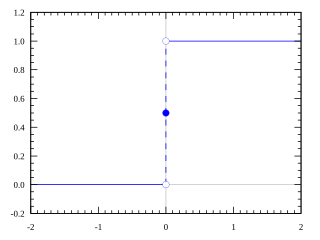Heaviside function
discontinuous function whose value is zero for negative numbers and one for positive numbers From Wikipedia, the free encyclopedia
The Heaviside function, often written as H(x), is a non-continuous function whose value is zero for a negative input and one for a positive input.

The function is used in the mathematics of control theory to represent a signal that switches on at a specified time, and which stays switched on indefinitely. It was named after the Englishman Oliver Heaviside.
The Heaviside function is the integral of the Dirac delta function: H′(x) = δ(x). This is sometimes written as[1]
Discrete form
We can also define an alternative form of the Heaviside step function as a function of a discrete variable n:
where n is an integer.
Or
The discrete-time unit impulse is the first difference of the discrete-time step
This function is the cumulative summation of the Kronecker delta:
where
is the discrete unit impulse function.
Representations
Often an integral representation of the Heaviside step function is useful:
H(0)
The value of the function at 0 can be defined as H(0) = 0, H(0) = ½ or H(0) = 1. In particular:[2]
Related pages
- Laplace transform
- Step function
References
Wikiwand - on
Seamless Wikipedia browsing. On steroids.


![{\displaystyle H[n]={\begin{cases}0,&n<0\\1,&n\geq 0\end{cases}}}](http://wikimedia.org/api/rest_v1/media/math/render/svg/efb65c686bdec46712eae1997c363f7ef8709b79)

![{\displaystyle \delta \left[n\right]=H[n]-H[n-1].}](http://wikimedia.org/api/rest_v1/media/math/render/svg/e6c417f161a7987a4db18818743eeb23494b0feb)
![{\displaystyle H[n]=\sum _{k=-\infty }^{n}\delta [k]\,}](http://wikimedia.org/api/rest_v1/media/math/render/svg/5db28db3163e2940aaf93d0fc180edb19d865d32)
![{\displaystyle \delta [k]=\delta _{k,0}\,}](http://wikimedia.org/api/rest_v1/media/math/render/svg/97a99ab7d257c74f38fbb2d42c8e42e1cb16d0e9)

